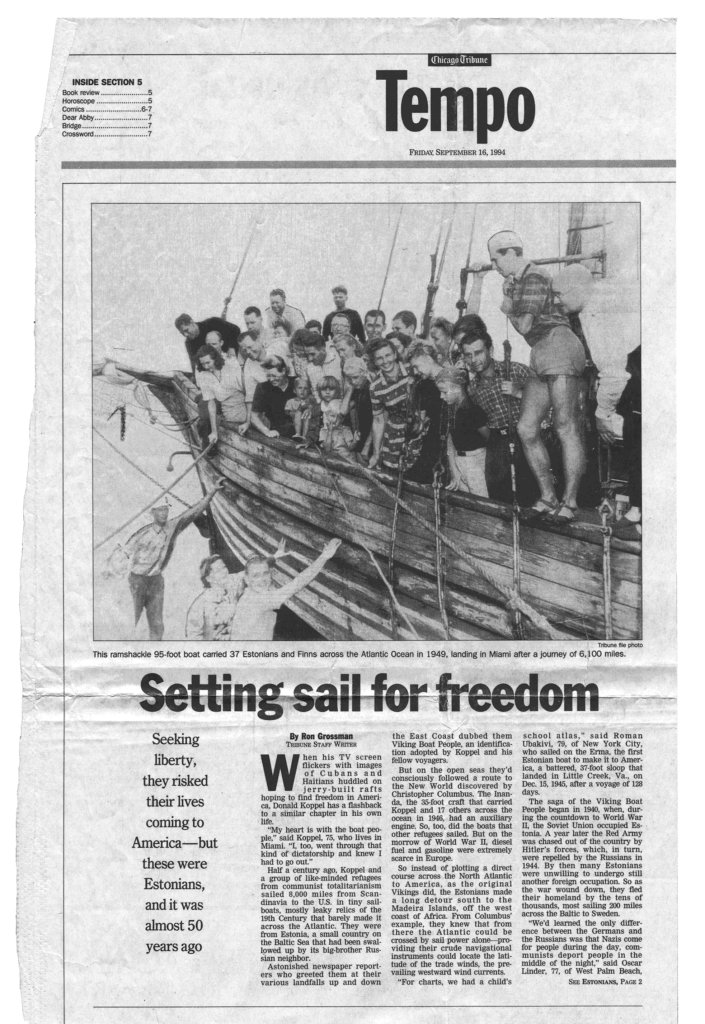Boats

“New Viking drama for Estonians.” Some refugee boats received a hostile reception when they entered foreign ports. The Eeva was almost forced to sail from Madeira across the Atlantic without necessary water, oil, and food. Välis-Eesti, January 23, 1949
eeva
The Eeva departed September 24, 1948, from Helsingborg, Sweden, with 22 Estonians and 15 Finns on board. Two of the Finns, Toivo Kaaria and Yrjo Haapanen, were, respectively, the motor yacht’s captain and owner.
On its way out of port, the 95-foot-long (29 meters) Eeva ran into a storm and lost both anchors between Sweden and Denmark. Despite this, the boat, with badly damaged sails, reached Dover, England, by early October. The next leg of the journey to Madeira took 33 days. Shortly before arriving on November 28, passengers were rationed to potatoes and half a liter of water daily. Firewood and coal supplies ran out. Haapanen had no money left, so the passengers pooled their remaining savings and bought 750 liters of diesel fuel and food in Madeira.
On December 1, 1948, the Eeva began sailing toward the Canary Islands, reaching Las Palmas three days later. The refugees received a hostile reception and were not allowed to enter the port. Eventually, they managed to exchange the Eeva’s winch engine and its 10-meter-long motorboat on board for 1,057 gallons (4,000 liters) of diesel fuel and food to last 45 days. On December 10, they left port and began the long, final leg to America.
With the help of trade winds, the rest of the journey went smoothly. On January 23, 1949, Välis-Eesti newspaper recounted the Eeva’s Christmas celebration:

In 1994, the Chicago Tribune published a feature on the 50th anniversary of the boats that escaped from Estonia and Sweden. The Eeva is shown with passengers after landing in Miami in January 1949.
“As was customary, a slightly drunken Santa made a visit, followed by a few Christmas carols, during which coffee, cheap cognac from the Canaries, as well as Madeira wines were served without snacks to get a buzz going. As in everything else, the eight Estonian women were at the forefront of the drinking… Apart from the captain, the Finnish crew and their families did not participate in the passengers’, i.e. the gentle people’s, Christmas celebration. However, the spectators in the open hatches of the cargo hold looked on as if in an amphitheatre and were amazed by the ‘high culture’ of these fraternal people.”
On January 11, 1949, the refugees arrived to a warm welcome at the port of Puerto Plata in the Dominican Republic. Supplies of drinking water, food, and fuel were replenished and the engine was repaired, all free of charge—courtesy of the president of the Dominican Republic.
The Eeva headed to Miami on January 17, reaching its final destination on January 21, 1949. The 6,100-mile voyage had lasted 120 days. Like the other Viking boats, no one on board had a visa, so the passengers continued their journey to Ellis Island in New York City, where they stayed until permission was granted to enter the United States.
Known crew and passengers:
- Captain Toivo Kaaria, wife Lyzli, and children Reio, Tuoma, and Tauno
- Owner Yrjo Haapanen, wife Ester, and children Seppo, Anna, Timo, and Eira
- Kaisa and Kalle Sierma
- Matti Viitala
- Arnold Puntsel
- Roland and Leida Emmus
- Eevald and Therese Eevola
- Evi Landov
- Linda (Liidia) Kattai
- Valdeko Liivat
- Bernhard(t) Kose
- Johannes Luts
- Rudolf Vooder
- Hermi Bataskov and son, Peeter
- August and Alma Tomson
- Maks and Salme Kersna
- Juhan Umbjärv
- Elmar, Armilda, and Atso Savisaar
- Heino Kiremia
